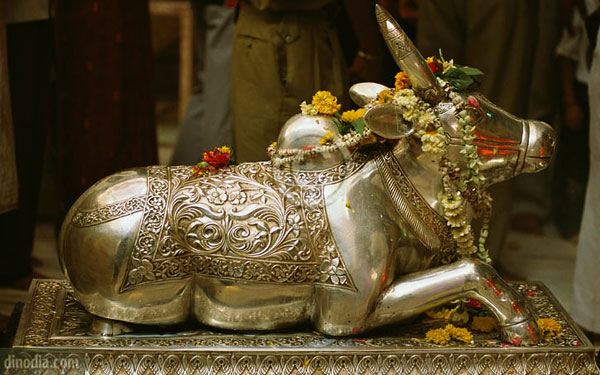Unclad body smeared with ashes: This form of Lord Shiva symbolizes the transcendental aspect of his nature and indicates that his presence is much higher than this physical phenomenon. The ashes on the Lord's body is cemetery ash, which points to the philosophy of the life and death and shows that death is the ultimate reality of the life. Most things in the universe reduce to ashes when burned and this aspect of nature is suggested by the ash-smeared appearance of Lord Shiva, who is held to be the God of destruction in Hindu mythology. The Lord is beyond the cycle of birth and death.
Jata (Matted Hair): The flow of his matted hair represents Shiva as the Lord of Wind or Vayu, who is the subtle form of breath present in all living beings. It shows that Shiva is Pashupatinath, Lord Of All Living Beings.
Sacred Ganga: The river Ganga (or Ganges) is the most sacred river for pious Hindus. According to a legend, the river Ganga has its source in Shiva and flows from his matted hair. This is symbolically represented by depicting Ganga as a jet of water sprinkling out of the head of the Lord and falling on the ground. Legend has it that the Lord allowed an outlet to the great river to traverse the earth and bring purifying water to human being. Hence, Lord Shiva is often referred to as Gangadhara or "Bearer of the river Ganga". The river Ganga also denotes fertility, one of the creative aspects of the Rudra. It also indicates that Shiva is not only the Lord of destruction but also the bestower of knowledge, purity and peace on the devotees.
The Third Eye: In the great Hindu epic Mahabharata, Lord Shiva is depicted as a three-eyed God. Hence, he is often referred to as Tryambaka Deva, meaning "three-eyed Lord". The sun is said to be his right eye, the moon the left eye while fire is his third eye. While his other two eyes indicate his activity in the physical world, his third eye in the center of his forehead looks beyond the obvious. It stands for spiritual knowledge and power, and is thus called the eye of wisdom or knowledge. Like fire, the powerful gaze of Shiva's third eye can search evil from anywhere and annihilate it completely. This is the reason why evil-doers fear his third eye.
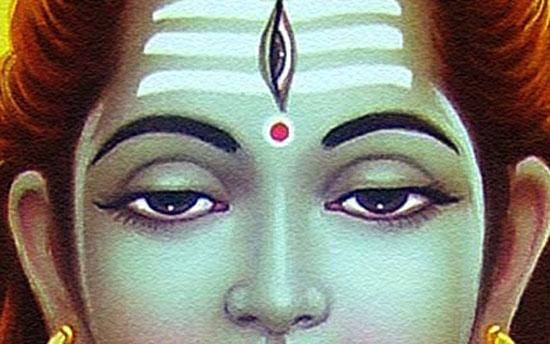
Half-Open Eyes: The half-open eyes of Lord Shiva convey the idea that the cycle of universe is in process. When the Lord opens His eyes a new cycle of creation begins and when He closes them it signifies the destruction of the universe for creation of the next cycle. The half-open eyes signify that creation is going through an eternal cyclic process, with no beginning and no end.
Crescent: Lord Shiva is typically pictured as wearing a crescent-shaped ornament on one side of his head. This is why he is often called 'Chandrasekhara' meaning "Having the moon as his crest". The Crescent is actually the moon in its fifth day phase and symbolizes the time cycle through which creation evolves from the beginning to the end. The moon is a measure of time, and thus the Crescent on Lord Shiva's head signifies his control over time. The Lord is the Eternal Reality and He is beyond time. Thus, the crescent moon is only one of His ornaments, and not an integral part of Him.
The Snake around the neck: Lord Shiva is often shown with a snake curled three times around His neck and looking towards His right side. The three coils of the snake symbolize the past, present and future - time in cycles. The snake looking in the right direction of Lord Shiva signifies that the Lord's perpetual laws of reason and justice preserve natural order in the universe. The snake is believed to be the Vasuki Naga, a deadly cobra. The Lord wearing the deadly snake like an ornament signifies that He is independent of time and death. It also suggests the dormant energy, called Kundalini Shakti, that resides within him.
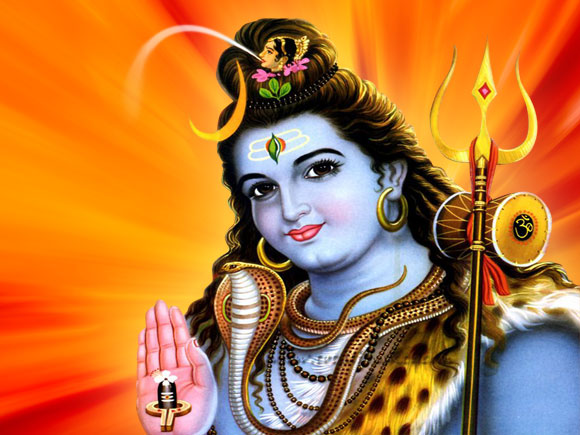
Vibhuti: The three line of ashes drawn on the forehead of the Lord is known as the Vibhuti. It signifies the Immortality of the Lord and his manifested glory.
Tiger Skin: Hindu mythology states that the tiger is the vehicle of Shakti, the Goddess of power and force. Lord Shiva is often shown seated upon or wearing a tiger skin, which emphasizes the fact that he is the master of Shakti and is beyond and above any kind of force. Tiger is also the emblem of lust. The Lord's sitting on Tiger skin indicates that he has conquered lust. Tiger also represents energy. Lord Shiva is the source of the creative energy that remains in potential form during the dissolution state of the universe. He activates this energy using his own Divine Will to project the universe in endless cycles.
The Elephant and Deer Skin: The Lord also wears elephant and deer skins. Elephants stand in for pride while deer represent the flickering mind. Wearing elephant and deer skin shows that Lord Shiva has conquered both these vices.
Rudraksha Necklace: He is almost always shown as wearing a necklace having 108 beads made with seeds of the Rudraksha tree. The beads represent the elements used in the creation of the world. The Rudraksha necklace points to the ‘Rudra’ aspect of the Lord, which is also His other name. The word 'Rudra' means "strict or uncompromising" and aksha means "eye." It illustrates the fact that Lord Shiva is firm about His cosmic laws and strictly maintains law and order in the universe.
Damaru (Drum): It is the small hourglass-shaped drum that the Lord holds in one of his hands in a specific gesture called 'damaru-hasta'. The two sides of the drum separated from each other by a thin neck-like structure represents the two utterly different states of existence, unmanifest and manifest. When a damaru is shaken, it produces Nada, the cosmic sound of AUM, which can be heard during deep meditation. According to Hindu scriptures, Nada is the source of creation. This is one of the attributes of Shiva in his famous dancing representation known as Nataraja.
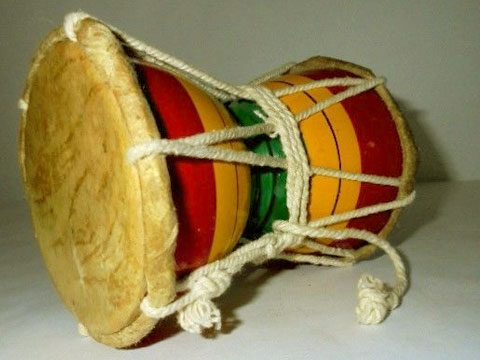
Trishul (Trident): The trident, or the spear with three prongs, is one of the accessories of the Lord and symbolizes His three fundamental powers iccha(will), kriya(action) and jnana(knowledge). It also signifies His power to destroy evil and ignorance. As His weapon and instrument of punishment the trident represents Lord Shiva's manner of punishing the evil doers on all the three planes - spiritual, subtle and physical.
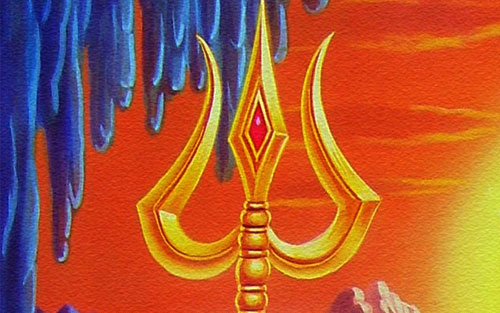
Kamandalu: The water pot (Kamandalu) often shown adjacent to the Lord is another of his accessories. It is said to be made from a dry pumpkin and containing amrit (nectar). Indian Yogis and sages are seen to carry the Kamandalu as an item of basic necessity. The carrying of the Kamandalu shows the yogic nature of the Lord. But it has a deeper significance. As a ripe pumpkin has been plucked from a plant, its fruit removed and shell cleaned for containing the nectar, an individual too must give up his attachment to the physical world and clean his inner self of egoistic desires to experience the bliss of the Self, symbolized by the nectar in the Kamandalu.
Kundalas: The Kundalas refer to the two ear rings, Alakshya (meaning "which cannot be shown by any sign") and Niranjan (meaning "which cannot be seen by mortal eyes"), worn by the Lord. The ornaments in the ears of the Lord signify that He is beyond ordinary perception. It is noteworthy that the kundala in the left ear of the Lord is of the type used by women and the one in His right ear is of the type used by men. The dual type of Kundalas represent the Shiva and Shakti (male and female) principle of creation.
Mount Kailasha or Mount Kailash: Lord Shiva is most often shown to be seated with the beautiful Himalayas serving as his backdrop. Mount Kailash in the Himalayas is said to be His traditional abode. In Hindu mythology, Mount Kailasha is said to represent the center of the universe. This denotes that Lord Shiva is 'Kailas' - the bestower of peace and also 'Kailashadhipati' meaning "Lord Of Mount Kailash".
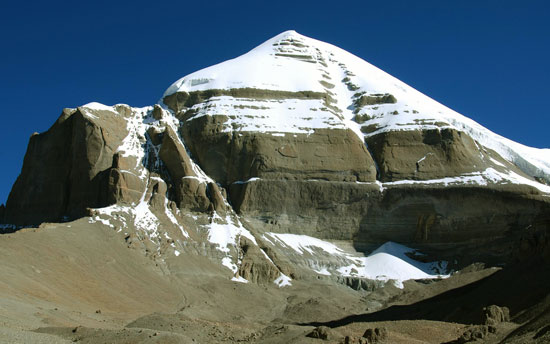
Nandi, the Bull: Nandi is the Bull of Lord Shiva and is said to be his vehicle. The bull is a symbol both of power and ignorance which suggests that Lord Shiva removes ignorance of his devotees and gives them the power of wisdom. In Sanskrit a bull is called "Vrisha" which also means "righteousness". The Nandi bull beside Lord Shiva indicates that He is the eternal companion of righteousness.
